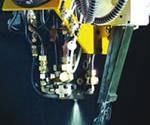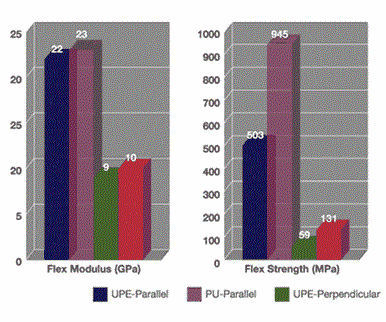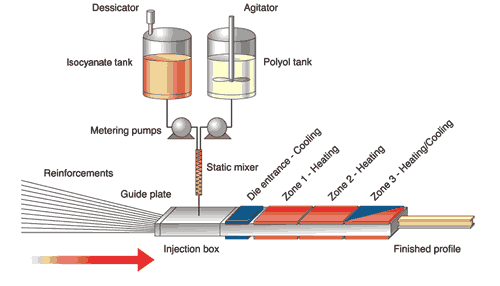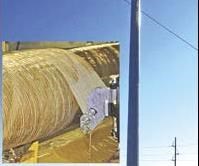Polyurethane Composites: New Alternative to Polyester and Vinyl Ester
High toughness, fast cure, and no styrene fumes are taking urethane composites beyond SRIM into pultrusion, filament winding, vacuum infusion, and spray-up.
Gains in processing know-how and advances in reactivity control to extend working time have placed polyure-thane in the running for composite applications long dominated by unsaturated polyesters and vinyl esters. In the last two decades, PUR composites made inroads primarily in foamed structural RIM (SRIM) automotive interior and exterior parts such as pickup truck boxes, load floors, package shelves, and inner door panels. Such applications have gained PUR 3% to 5% of the long-fiber and continuous-fiber composite market.
But the last six years have seen development of PUR pultrusion, filament winding, vacuum infusion and long-fiber spraying technologies. Primarily non-foamed, full-density PUR composite systems are being used with these traditional composite processes for applications from window lineals and bathtubs to electric light poles and large parts for trucks and off-road vehicles.
Why polyurethane?
PUR composites are produced with rigid thermoset resins, as opposed to elastomeric or thermoplastic polyurethane (TPU). “Composites manufactured from these PU resins have superior tensile strength, impact resistance, and abrasion resistance compared with composites based on unsaturated polyester and vinyl ester resins,” says Michael Connolly, composites product manager at Huntsman Polyurethanes. He cites typical values for tensile modulus around 430,000 psi, tensile strength of about 12,500 psi, and elongation to failure of over 7.5%. Craig Snyder, market channel representative for non-automotive applications at Bayer MaterialScience, adds that reinforced PUR can be foamed to provide weight savings of up to 20%.
Connolly points out that the superior toughness of PUR composites pays off in secondary operations such as drilling, machining, and assembly. Machined and punched edges exhibit little or no micro-cracking compared with traditional thermoset composites, he says. “We recently measured force to pull out a self-tapping screw and found that the force in PUR profiles is 40% higher than that for a hybrid polyester/PUR composite, and 50% and 60% higher than for vinyl ester and polyester, respectively.”
PUR composites are also said to be attractive for their processing advantages. Cure times are much faster than for polyester spray-up—about 20 min versus 2 to 4 hr in non-automotive applications, notes Bayer’s Snyder. PUR spray processes are also much less labor-intensive than polyester spray-up, which requires rolling out the glass to remove air and ensure complete wet-out.
In automotive parts, PUR SRIM takes 30 sec to 2 min vs. 2 to 10 min for polyester and vinyl ester SMC, says Terry Seagrave, Bayer’s market channel manager for NAFTA automotive business. Labor is also re duced with PUR composite automotive components, because SMC re-quires intermediate steps to prepare and B-stage the sheet. Snyder also notes that tooling costs are much lower than for SMC because of the lower pressures for SRIM.
There has also been a downside to the reaction speed of polyurethanes. According to Lisa Shaner, marketing manager at PUR machinery supplier Krauss-Maffei Corp., “In the past, a drawback to producing large glass-reinforced PUR parts was the fact that the chemistry was so fast that it often did not leave sufficient time to close the press.” However, the flexibility of PUR chemistry and new equipment designs have overcome that previous limitation.
“While current technology does not allow use of PUR resins for long open times of more than a few hours or for processing into prepregs intended for storage and later use, the fast reactivity of PUR makes it a good candidate for some open-mold processes, such as spray-up of tubs, provided the appropriate engineering controls are in place for MDI,” says Connolly.
PUR composites have another advantage: They contain no styrene and do not generate large amounts of volatile organic compounds (VOCs). On the other hand, PUR does contain MDI, which is a regulated material. However, Bayer sources believe that MDI emissions from PUR composite processing should usually be negligible due to the low vapor pressure of MDI and results of industry emissions tests.
OSHA’s permissible exposure limits for MDI are 0.02 ppm as a short-term ceiling value and 0.005 ppm as an 8-hr time-weighted average. “Our experience in workplace exposure monitoring indicates that unless MDI is heated or sprayed, the likelihood of these limits being exceeded is small,” says James Chapman, Bayer’s director of product safety. He says proper ventilation is used to control workplace exposures. In addition, protective equipment such as gloves and eyewear are recommended.
The Regulatory Compliance Assistance Program (RECAP) of the Alliance for the Polyurethanes Industry helps processors determine their MDI emissions for environmental permits and EPA Toxic Release Reporting. (RECAP can be accessed at www.polyurethane.org/regulatory/emissions.asp.)
SRIM & its variants
Advances in SRIM materials and processing equipment have made this the fastest growing area of PUR RIM and a promising alternative for processors of composites via RTM, spray-up, and SMC. Traditional SRIM has a lot in common with RTM. Like RTM, it is a closed-mold process whereby a glass preform or mat is placed in the mold, which is then closed and the PUR chemicals are injected. But newer advances in RTM have turned it into more of an automated spray operation.
Robotic “spray-in-mold” or “spray molding” systems emerged in 1995 with the Long-Fiber Injection (LFI) process of Krauss-Maffei, which chops and wets out glass fibers inside the mixhead. The reinforced mix is sprayed onto the bottom half of an open mold. The mold is then closed to cure the part. Because the glass is wetted inside the head, no rollout is needed.
Other competing SRIM technologies of this type are InterWet from Cannon and CSM Baydur (formerly called FipurTec) from Hennecke Machinery Div. of Bayer MaterialScience. Since 1999, each of these three OEMs also has offered variants of these processes that allow for use of natural fibers.
More recently, Bayer introduced three more CSM (Composite Spray Molding) variants to the U.S. (they are already established in Europe). Two of them are CSM-Baypreg and CSM- Baypreg NF. The former produces Baypreg sandwich panels consisting of a paper honeycomb combined with glass-fiber mats that are impregnated with PUR chemicals sprayed onto both sides of the lay-up. The laminate is then compression molded and cured under heat. The panels are said to have greater lightweighting potential than other sandwich products, making them attractive for automotive and other applications. A recent example is the roof sun shade that replaced SMC on the 2005 Toyota Avalon.
The CSM-Baypreg NF (Natural Fiber) process (formerly called NafpurTec) is quite similar, but it yields thin-walled and extremely lightweight automotive components made from natural-fiber mats without a honeycomb core. Inner door panels are a prime application.
Bayer’s newest process is the CSM-Multitec short-fiber PUR system, a version of open-mold spray-up. The PUR mixture is applied in several layers, solid or foamed, with or without reinforcement, and is allowed to cure in the open mold. In this process, glass fibers are chopped 5 to 12.5 mm (0.2 to 0.5 in.) long in an external chopper device mounted on the PUR spray gun. Explains Lutz Heidrich, Hennecke’s manager of molded foam, “Traditional PUR equipment manufacturers are adding glass choppers to their two-component PUR equipment, and polyester spray equipment makers are adapting their equipment for PUR.”
Beyond foamed SRIM
Foamed low-density SRIM has dominated PUR composites for several years, particularly in auto interior applications such as door panels. More recently, non-foamed, high-density SRIM systems were proved viable. One of the first cases was the cargo box of the 2001 GM Silverado 1500 pickup truck, based on Bayer’s Baydur 426 HD-SRIM PUR system. A more recent use of the same system is the inner midgate panel of the 2005 Chevrolet Avalanche hybrid utility vehicle.
A breakthrough application for large, non-automotive, “solid” PUR long-fiber composites was unveiled last year with the new line of exterior residential doors from Jeld-Wen of Klamath Falls, Ore. The solid Baydur STR composite system is used to form the skins of the doors using Krauss-Maffei’s LFI system. “The lower molding pressure makes this more economical than compression molding with SMC,” says Bayer’s Snyder.
Huntsman’s Connolly says his company has worked on projects using both the InterWet and LFI processes to make full-density PUR composites. “Parts as large as a tailgate and tonneau cover have been produced by these process methods.”
Bayer’s CSM-Multitec allows cost-effective production of larger molded parts than other CSM techniques and is also suited to small-to-medium production runs. Recent commercial applications include tractor hoods and fenders and bathtubs—which made their debut in Europe last year. One bathtub has a thermoformed cast-acrylic skin backed up with Baydur 60 rigid PUR integral-skin foam. Eight layers of Multitec, some foamed, some solid, with 12-mm chopped glass are sprayed onto the back of the tub skin. The composite backing only takes 3 to 5 min to cure.
BASF has been focusing on sprayed PUR composite applications such as spas and recreational vehicles as a one-to-one replacement for polyester composites. According to technical services supervisor Jim Turnbach, large spas up to 20 ft2 can be made with combinations of full-density rigid PUR, elastomers, and foam. BASF has also worked on smaller R.V. components such as front caps and back sections, but Turnbach sees potential for large applications such as side panels.
A hit in pultrusion
Polyurethane pultrusion is here to stay despite having taken several years to come to commercial fruition. While it appears that not more than a handful of pultruders are currently processing polyurethane profiles, material suppliers confirm that several developmental programs are under way.
North American pultruders are seeing strong competition from China in products such as ladder rails and tool handles, says Huntsman’s Connolly. The added toughness and strength of PUR give domestic pultruders an opportunity to distinguish their products, he notes.
A widely acknowledged leader and pioneer in PUR pultrusion is Creative Pultrusions, which has more than five years’ commercial experience in this area. It offers an eight-page brochure on its SupurTuf PUR pultrusion on its website. New business development manager Dustin Troutman says the firm currently offers more than 25 PUR pultruded profiles. They range from ladder rails and electrical cross arms to sheet pilings for waterfront bulkheads and other high-strength, high-impact applications in construction, transportation, and infrastructure.
Huntsman has led the thrust into pultrusion with development of non-foamed formulations specifically suited to this process as well as filament winding and vacuum infusion. BASF has also developed such resin systems, and Bayer plans to launch Baydur PUL 2000 systems for pultrusion this year.
Catalyst and resin developments allowed Huntsman to extend PUR gel times at room temperature to more than 30 min. Despite the extended resin pot lives, these systems still maintain rapid cure rates at the elevated temperatures used for pultrusion. As a result, line speeds of over 6 ft/min have been achieved for unidirectional pultruded profiles, similar to the best polyesters but much faster than the typical 2 to 4 ft/min for vinyl esters and 1 to 2 ft/min for epoxies, according to Connolly. One Huntsman customer, CE Composites Inc. of Ottowa, Ont., has been pultruding PUR hockey sticks for several years.
A typical polyurethane pultrusion set-up includes a two-component feed system running out of drums or pots, a range of pump assemblies, and a transfer line into a conventional PUR low-pressure mixing head with a static mixer. A closed resin injection process is generally used with PUR.
The main market so far for PUR pultrusion is smaller profiles such as ladder rails, tool handles, and rods. Window lineals are a promising new area of growth. Experienced pultruders today are making PUR channels and I-beams up to 6 x 6 in. Larger I-beams—over 1 ft square—remain a challenge for PUR because they would require extended pot life in an open impregnation bath, where the MDI could react with atmospheric moisture. Huntsman’s Connolly indicates that this hurdle could be overcome. In recent trials, much larger parts than have been produced commercially to date were achieved by Huntsman, although he won’t disclose the size.
Urethane’s exceptional impact and tensile strengths, plus interlaminar shear strength more than double that of polyester, may allow existing pultrusion applications to be re-engineered for lighter weight and lower cost. For example, Connolly says an I-beam of PUR can be made thinner and lighter by using less continuous-strand mat (CSM) and a higher proportion of glass roving. “By reducing from three to two layers of CSM, and replacing some CSM with roving, the I-beam thickness can be reduced from 3.3 mm to 2.6 mm while maintaining longitudinal stiffness.” He says this results in 7% lower cost and 13% lower weight.
Troutman from Creative Pultrusions says very thin sections can be pultruded with PUR. “Polyurethane allows you to reduce weight and fabrication cost and eliminate surface preparation prior to bonding.” He says the cost of PUR pultruded profiles is in line with that of high-end vinyl ester profiles. He adds, “Pultrusion applications that were not feasible in polyester and vinyl ester due to strength limitations are now practical with superior-performing polyurethanes.”
PUR filament winding, too
Replacing polyester composites in filament winding, a market two to three times bigger than pultrusion, is very much of interest to PUR suppliers. One recent breakthrough is the RStandard modular composite utility pole, manufactured by RS Technologies of Calgary, Alberta, using its proprietary Version PUR resins and a patented filament winding process. Made in lengths up to 135 ft, it is the first all-PUR pole and the first use of composites for electrical transmission poles. Polyester composites are used mostly for smaller distribution poles.
The inner layer of the pole is made with an aromatic grade of Version PUR, while two layers of aliphatic resins are used on the outside. This resin system is said to be stronger and tougher than polyester, vinyl ester, or epoxy and to offer a greater strength-to-weight ratio. Also, proprietary fiber-placement technology reportedly cuts the amount of reinforcement needed to make poles that have strength equal to or better than those made with traditional thermosets.
The special filament winding system makes zero-degree winds, placing fiberglass in the axial plane of the pole, while typical winding processes can create minimum wind angles of 7° to 8°. Optimized placement of glass and resin can reduce thickness and overall weight by up to 45%.
RS Technologies developed some of its own machinery for a system that can wind 2200 lb/hr. In most cases, standard mandrels, heaters, and control systems are used without modification. The composite poles are heat cured.
Other applications where PUR composites have potential to replace polyesters in filament winding include infrastructure, according to Connolly. BASF has been active in PUR filament winding, particularly in Europe, where the target is “long-term infrastructure” that requires good corrosion resistance, notes Turnbach.
Another potential market is filament-wound pipes for corrosion-resistant applications or potable-water infrastructure in places like the Middle East and Southeast Asia, says Connolly. Hot-water tanks are another promising area, he says: “Early trials have revealed 40% to 50% improvements in burst strength of PUR filament-wound tanks over those using polyester.”
PUR vacuum infusion
The viability of PUR vacuum infusion, a version of RTM designed for very large parts (e.g., boat hulls), is also being explored. This approach requires only one mold half, plus a plastic film to cover the lay-up. According to Connolly, achievement of more than 30-min pot life for PUR makes possible fabrication of parts by RTM, VARTM, and other infusion pro cesses. “We have been successful at infusing moderately large parts—using over 50 lb of resin—in trials at customer sites and aim to have these components commercially launch ed in the near future. The commercial viability of infusing PUR into very large parts—greater than 500 lb of resin—is unclear, but it may be possible.”
Bayer’s Snyder says new formulations look promising for vacuum infusion. RS Technologies is exploring both vacuum infusion and pultrusion using its Version PUR resins.
Read Next
Troubleshooting Screw and Barrel Wear in Extrusion
Extruder screws and barrels will wear over time. If you are seeing a reduction in specific rate and higher discharge temperatures, wear is the likely culprit.
Read MoreLead the Conversation, Change the Conversation
Coverage of single-use plastics can be both misleading and demoralizing. Here are 10 tips for changing the perception of the plastics industry at your company and in your community.
Read More






%20technology.jpg;width=860)















.png;maxWidth=300;quality=90)









